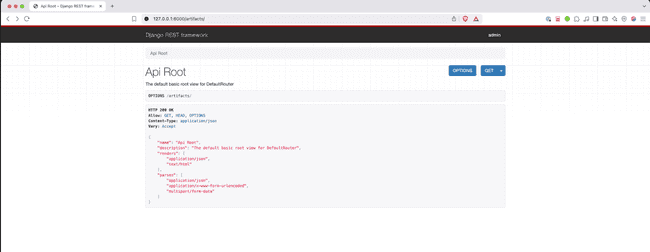Building HTTP APIs With Django REST Framework
June 06, 2025https://realpython.com/courses/django-rest-framework/
REST
- Client-server architecture
- Stateless
- Cacheable
- Layered system
- Code on demand
- Uniform interface
- Resources are identified as requests
- Resource manipulation through representations
- Self-descriptive messages
- Hypermedia as the engine of application state (HATEOAS)
Django REST Framework
- Toolkit for developing RESTful APIs in Django
- Integrastes with Django models, views and URL patterns
- Provides mechanisms for both function and class based views
- Serialization for both ORM and non-ORM data sources
- Built-in web interface
- https://www.django-rest-framework.org/
DRF Serialization and Views
- Serializers
- Change objects into text aqnd text back into objects
- With or without Django ORM
- Views
- Utilities to write Django views that serialize and deserialize data
# people/models.py
from django.db import models
class Person(models.Model):
first = models.CharField(max_length=50)
last = models.CharField(max_length=50)
title = models.CharField(max_length=5)
class Meta:
verbose_name_plural = "People"
# people/serializers.py
from rest_framework import serializers
from .models import Person
class PersonSerializer(serializers.ModelSerializer):
class Meta:
model = Person
fields = ['id', 'first', 'last', 'title']
# people/views.py
from rest_framework.decorators import api_view
from rest_framework.response import Response
from .models import Person
from .serializers import PersonSerializer
@api_view(['GET'])
def list_people(request):
people = Person.objects.all()
serializer = PersonSerializer(people, many=True)
content = {
"people": serializer.data
}
return Response(content)
curl -s http://127.0.0.1:8000/people/list_people/ | python -m json.tool
DRF ViewSets
- ViewSets
- Class based utilities for encaspsulating common REST/HTTP methods
- Automatically get List, Retrieve, Create, Update, Update Partial, and Delete actions
- Router define all the URL mappings
- Routers
- Map between ViewSets and Django URL routes
# artifacts/views.py
from rest_framework import viewsets
from .models import Artifact
from .serializers import ArtifactSerializer
class ArtifactViewSet(viewsets.ModelViewSet):
serializer_class = ArtifactSerializer
def get_queryset(self):
return Artifact.objects.all()
# artifacts/urls.py
from django.urls import path, include
from rest_framework.routers import DefaultRouter
from . import views
router = DefaultRouter()
router.register(r'artifacts', views.ArtifactViewSet, 'artifact')
urlpatterns = [
path('', include(router.urls)),
]
curl -s http://127.0.0.1:8000/artifacts/ | python -m json.tool # prints router urls
curl -s http://127.0.0.1:8000/artifacts/artifacts/ | python -m json.tool
curl -s http://127.0.0.1:8000/artifacts/artifacts/2/ | python -m json.tool
curl -s -X POST -d "name=Ark of the Covenant" -d "shiny=True" http://127.0.0.1:8000/artifacts/artifacts/ | python -m json.tool
curl -s -X PUT -d "name=Golden Idol" -d "shiny=True" http://127.0.0.1:8000/artifacts/artifacts/1/ | python -m json.tool
curl -s -X PATCH -d "shiny=False" http://127.0.0.1:8000/artifacts/artifacts/1/ | python -m json.tool
curl -s -X DELETE http://127.0.0.1:8000/artifacts/artifacts/1/
Web Interface and Renderers
- Web Interface
- Out of the box, DRF comes with a web interface
- Renderers
- Type of response is based on:
- Renderers installed
- HTTP Accept header
- Change the renderer in settings.py
- Alternatively, you can set the renderer in the viewset
- Third party packages for more formats
- Type of response is based on:
Permissions
- DRF
IsAdminUseris more likeis_staff - object level can be checked
- By default inside of BasePermission, permission is granted
- Listing is different than updates/items
- A few things can acccidentally expose things
from django.contrib.auth.decorators import login_required
from django.shortcuts import render
from rest_framework import viewsets
from rest_framework.permissions import BasePermission
from .models import Book
from .serializers import BookSerializer
class IsSuperUser(BasePermission):
def has_permission(self, request, view):
return request.user.is_superuser
def has_object_permission(self, request, view, obj):
return request.user.is_superuser
class IsIndy(BasePermission):
def has_object_permission(self, request, view, obj):
if not obj.restricted:
return True
return request.user.username == 'indy'
class BookViewSet(viewsets.ModelViewSet):
serializer_class = BookSerializer
permission_classes = [IsIndy | IsSuperUser]
def get_queryset(self):
if self.request.user.is_staff:
return Book.objects.all()
return Book.objects.filter(restricted=False)
@login_required
def library(request):
return render(request, 'library.html')
Serializers without ORM
- Inherit from
serializers.Serializerclass and combine fields to construct arbitrary objects - similar to how you declare ORM objects
- https://www.django-rest-framework.org/api-guide/fields/
# vehicles/models/tools.py
class Tool:
def __init__(self, name, make):
self.name = name
self.make = make
# vehicles/serializers/tools.py
from rest_framework import serializers
class ToolSerializer(serializers.Serializer):
name = serializers.CharField(max_length=50)
make = serializers.CharField(max_length=50)
# vehicles/views/tools.py
from rest_framework.decorators import api_view
from rest_framework.response import Response
from vehicles.models import Tool
from vehicles.serializers.tools import ToolSerializer
@api_view(['GET'])
def list_tools(request):
tools = [
Tool("hammer", "Mastercraft"),
Tool("wrench", "Husky")
]
serializer = ToolSerializer(tools, many=True)
content = {
"tools": serializer.data
}
return Response(content)
Nested Django ORM objects
- DRF provides methods for serializing related ORM objects
- Reference foreign keys by id
- Nest serialized relationships
# vehicles/models/vehicles.py
from django.db import models
class Vehicle(models.Model):
name = models.CharField(max_length=100)
class Part(models.Model):
name = models.CharField(max_length=100)
make = models.CharField(max_length=100)
vehicle = models.ForeignKey(Vehicle, on_delete=models.CASCADE)
# vehicles/serializers/vehicles.py
from rest_framework import serializers
from vehicles.models import Vehicle, Part
class SerialNumberField(serializers.Field):
def to_representation(self, value):
code = value.make[:3].upper()
return f"{code}-{value.id}"
class PartSerializer(serializers.ModelSerializer):
serial_no = SerialNumberField(source="*")
class Meta:
model = Part
fields = ["url", "name", "vehicle", "serial_no"]
class VehicleSerializer(serializers.ModelSerializer):
part_set = PartSerializer(many=True, read_only=True)
class Meta:
model = Vehicle
fields = ["url", "name", "part_set"]
# vehicles/views/vehicles.py
from rest_framework import viewsets
from rest_framework.response import Response
from vehicles.models import Vehicle, Part
from vehicles.serializers.vehicles import VehicleSerializer, PartSerializer
class PartViewSet(viewsets.ModelViewSet):
queryset = Part.objects.all()
serializer_class = PartSerializer
class VehicleViewSet(viewsets.ModelViewSet):
serializer_class = VehicleSerializer
def get_queryset(self):
return Vehicle.objects.all()
ViewSet Actions
- compounded serialization
- A common pattern is to declare an API that includes multiple objects
- Everything you might need in a single-page application
- Delcare aq view and nest multiple serializers
# api/urls.py
from django.urls import path, include
from rest_framework.routers import DefaultRouter
from . import views
router = DefaultRouter()
router.register(r"doctors", views.DoctorsViewSet, "doctors")
router.register(r"mass_delete", views.MassDeleteArtifactsViewSet, "mass_delete")
urlpatterns = [
path("v1/", include(router.urls)),
path("v1/listing/", views.listing),
]
# api/views.py
from rest_framework import viewsets, mixins
from rest_framework.decorators import action, api_view
from rest_framework.response import Response
from artifacts.models import Artifact
from people.models import Person
from vehicles.models import Vehicle
from people.serializers import PersonSerializer
from vehicles.serializers.vehicles import VehicleSerializer
class DoctorsViewSet(mixins.ListModelMixin, viewsets.GenericViewSet):
def list(self, request):
doctors = Person.objects.filter(title="Dr.")
results = {
"doctors": PersonSerializer(doctors, many=True).data,
}
return Response(results)
class MassDeleteArtifactsViewSet(mixins.DestroyModelMixin,
viewsets.GenericViewSet):
@action(detail=False, methods=["delete"])
def mass_delete(self, request, pk=None):
for artifact_id in request.POST['ids'].split(","):
Artifact.objects.get(id=artifact_id).delete()
return Response()
@api_view(["GET"])
def listing(request):
doctors = Person.objects.filter(title="Dr.")
Vehicles = Vehicle.objects.all()
context = {
"request": request,
}
vehicle_serializer = VehicleSerializer(Vehicles,
many=True,
context=context)
results = {
"doctors": PersonSerializer(doctors, many=True).data,
"vehicles": vehicle_serializer.data,
}
return Response(results)
